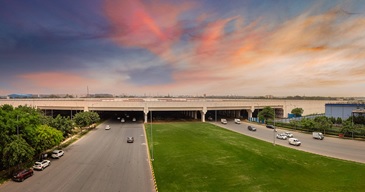A team of intelligence bureau (IB) officers has found several lapses at the dual elevated Eastern Cross taxiways (ECTs) — a threat to the aircraft security — and asked the Bureau of Civil Aviation Security (BCAS) to take action in the matter at the earliest.
In July 2023, Civil Aviation Minister Jyotiraditya Scindia inaugurated the ECT at the Indira Gandhi International Airport (IGIA) — the only airport in the country to have an elevated taxiway with roads passing below it.
After visiting the ECT, the IB shared their report with the BCAS, CISF, Delhi Police and asked them to take proper action. On January 9, a joint inspection was conducted by all the concerned agencies and they have decided to make a patrolling team.
The intelligence bureau officers recently visited the ECT after being informed about the laxity in security arrangements, said a source, requesting anonymity. “After visiting the ECT, they found that the safety and security of the aircraft and its passengers were at risk as its taxiing was clearly visible from the area. Even the non-metaled road outside the perimeter wall and running parallel to the ECT has become a parking area for vehicles. Also, fencing along the ECT rampart could easily be crossed over with the support of vehicles parked there — a major threat to aircraft security,” said the source. A perimeter wall is the exterior wall surrounding a structure or a building.
During the security audit, they found out that several people also travel on the 2.1-km-long ECT road as no dedicated officers from agencies concerned were deployed to check the same.
“The area is isolated now, and the CISF or the Delhi Police do not patrol the area. There is a sentry post near the road leading to IGIA — the largest airport in the country — below the ECT, but there were no security personnel. This sentry post could be used as a hideout for wrongful activities,” said the source, citing the audit report.
The ECT has reduced the travel time on the tarmac by passengers, before flight departure and landing. “It was found out during the audit that at many places along the ECT stretch, the perimeter wall had gone short due to soil deposition… Anyone can easily climb the perimeter wall and enter the apron side,” said the source.
According to officers, the 2.1-km-long and .20-m-wide ECT has connected the northern and southern airfields on the eastern side of the airport and reduced the taxiing distance for an aircraft by seven kilometres. The ECT is wide enough to accommodate two aircraft at the same time, including big aircraft such as A-380 and B-777 among others.
The objective of the ECT is to not only reduce the waiting time for passengers, but also cut down on aircraft fuel and emissions, while enhancing operational efficiency. The ECT was constructed under the Phase 3A Expansion Works project, the contract of which was in 2019 awarded to Larsen and Toubro (L&T) that has also worked on the fourth runway — which is the newest.








